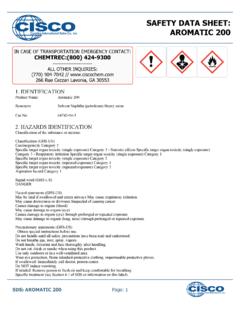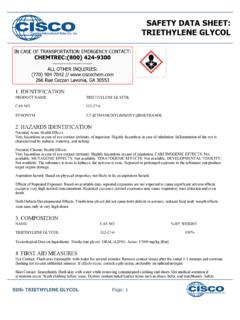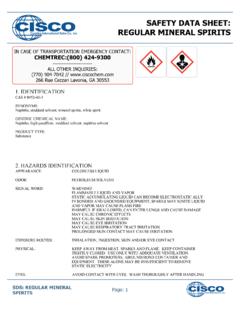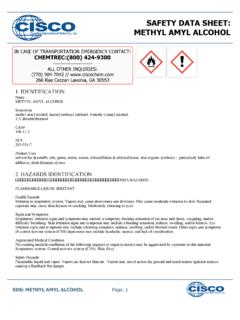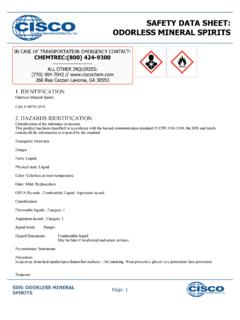Transcription of SAFETY DATA SHEET: AROMATIC 150
1 SAFETY DATA SHEET: AROMATIC 1501. IDENTIFICATIONNAME: AROMATIC 150 CAS NUMBER:64742-94-5 CHEMICAL NAME:SOLVENT naphtha ( petroleum ), HEAVY AROMATICABBREVIATIONS:A-150, S-150 SYNONYMS:High Flash AROMATIC naphtha , Type IIHeavy AROMATIC Solvent Naphthahydrocarbons, C10 Aromatics, >1% naphthalene2. HAZARDS IDENTIFICATIONGHS CLASSFLAMMABLEASPIRATIONCHRONIC AQUATIC TOXIC(Category)(4)(2)(2)Signal Words:WARNINGWARNINGNo Signal WordHazard Statements:Combustible liquidmay be harmfulToxic to aquatic life(H227)if swallowed & with long-lastingenters airwayeffects(H305)(H411)3.
2 COMPOSITIONC omposition:Heavy AROMATIC Solvent NapthtaCAS # 64742-94-5% : 100%TWAEV/TLV (mg/m3): 400/1600LD50 (mg/kg) ORAL: 7050LD50 (mg/kg) SKIN: >2000LC50 PPM INHALATION:5100IN CASE OF TRANSPORTATION EMERGENCY CONTACT:CHEMTREC:(800) 424-9300-----------------------ALL OTHER INQUIRIES:(770) 904-7042 // Rue Cezzan Lavonia, GA 30553 Page: 1 SDS: AROMATIC 150 NapthaleneCAS# 91-20-3%0-5%TWAEV/TLV (mg/m3): 10/50 (skin)LD50 (mg/kg) ORAL:1870LD50 (mg/kg) SKIN: >2500LC50 PPM INHALATION:106-142 CumeneCAS# 95-62-6%0-2%TWAEV/TLV (mg/m3): 50/245LD50 (mg/kg) ORAL:1400LD50 (mg/kg) SKIN: 10,630LC50 PPM INHALATION:2000 Trimethylbenzene (Psuedocumene)CAS# 98-82-8%0-2%TWAEV/TLV (mg/m3): 25/125LD50 (mg/kg) ORAL:5000LD50 (mg/kg) SKIN: not knownLC50 PPM INHALATION:36704.
3 FIRST AID MEASURESSKIN:Wash with soap & plenty of water. Remove contaminated clothing & do not reuse untilthoroughly :Wash eyes with plenty of water, holding eyelids open. Seek medical assistance promptlyif there is :Remove from contaminated area promptly. CAUTION: Rescuer must not endangerhimself! If breathing stops, administer artificial respiration and seek medical aid :Give plenty of water to dilute product. Do not induce vomiting (NOTE below). Keep victimquiet. If vomiting occurs, lower victim s head below hips to prevent inhalationof vomited material.
4 Seek medical help TO PHYSICIAN: IF INGESTED, MATERIAL MAY BE ASPIRATED INTO THE LUNGS AND CAUSE CHEMICALPNEOMONITIS, TREAT inhalation of vomited material may seriously damage the lungs. The danger of this is greater than the risk of poisoningthrough absorption of this relatively low-toxicity substance. The stomach should only be emptied under medical supervision, andafter the installation of an airway to protect the ENSURE THAT THIS MSDS IS GIVEN TO, AND EXPLAINED TO PEOPLE USING THIS PRODUCTPage: 2 SDS: AROMATIC 1505. FIRE FIGHTING MEASURESEXTINGUISHING MEDIAA ppropriate Extinguishing Media: Use water fog, foam, dry chemical or carbon dioxide (CO2) to extinguish Extinguishing Media: Straight Streams of WaterFIRE FIGHTINGFire Fighting Instructions: Evacuate area.
5 Prevent runoff from fire control or dilution from entering streams, sewers, or drinkingwater supply. Firefighters should use standard protective equipment and in enclosed spaces, self-contained breathing apparatus(SCBA). Use water spray to cool fire exposed surfaces and to protect Fire Hazards: Combustible. Vapors are flammable and heavier than air. Vapors may travel across the ground and reachremote ignition sources causing a flashback fire danger. Hazardous material. Firefighters should consider protective equipmentindicated in Section Combustion Products: Smoke, Fume, Incomplete combustion products, Oxides of carbonFLAMMABILITY PROPERTIESF lash Point [Method]: 63C (145F) [ ASTM D-56]Flammable Limits (Approximate volume % in air): LEL: UEL: Temperature: 455 C (851 F)6.
6 ACCIDENTAL RELEASE MEASURESNOTIFICATION PROCEDURESIn the event of a spill or accidental release, notify relevant authorities in accordance with all applicable regulations. US regulationsrequire reporting releases of this material to the environment which exceed the applicable reportable quantity or oil spills whichcould reach any waterway including intermittent dry creeks. The National Response Center can be reached at (800) MEASURESA void contact with spilled material. Warn or evacuate occupants in surrounding and downwind areas if required due to toxicity orflammability of the material.
7 See Section 5 for fire fighting information. See the Hazard Identification Section for SignificantHazards. See Section 4 for First Aid Advice. See Section 8 for Personal Protective MANAGEMENTLand Spill: Eliminate all ignition sources (no smoking, flares, sparks or flames in immediate area). Stop leak if you can do it withoutrisk. All equipment used when handling the product must be grounded. Do not touch or walk through spilled material. Prevent entryinto waterways, sewer, basements or confined areas. A vapor suppressing foam may be used to reduce vapors.
8 Use clean non-sparking tools to collect absorbed material. Absorb or cover with dry earth, sand or other noncombustible material and transfer tocontainers. Large Spills: Water spray may reduce vapor; but may not prevent ignition in closed spaces. Small Spills: Absorb withearth, sand or other noncombustible material and transfer to containers for later disposal. Recover by pumping or with Spill: Stop leak if you can do it without risk. Confine the spill immediately with booms. Warn other shipping. Remove fromthe surface by skimming or with suitable absorbents.
9 Seek the advice of a specialist before using spill and land spill recommendations are based on the most likely spill scenario for this material; however, geographicconditions, wind, temperature, (and in the case of a water spill) wave and current direction and speed may greatly influence theappropriate action to be taken. For this reason, local experts should be consulted. Note: Local regulations may prescribe or limitaction to be PRECAUTIONSL arge Spills: Dike far ahead of liquid spill for later recovery and disposal. Prevent entry into waterways, sewers, basements orconfined HANDLING AND STORAGEPage: 3 SDS: AROMATIC 150 HANDLINGA void breathing mists or vapors.
10 Avoid contact with skin. Potentially toxic/irritating fumes/vapors may be evolved from heated oragitated material. Use only with adequate ventilation. Prevent small spills and leakage to avoid slip hazard. Material can accumulatestatic charges which may cause an electrical spark (ignition source). When the material is handled in bulk, an electrical spark couldignite any flammable vapors from liquids or residues that may be present ( , during switch-loading operations). Use properbonding and/or ground procedures. However, bonding and grounds may not eliminate the hazard from static accumulation.
